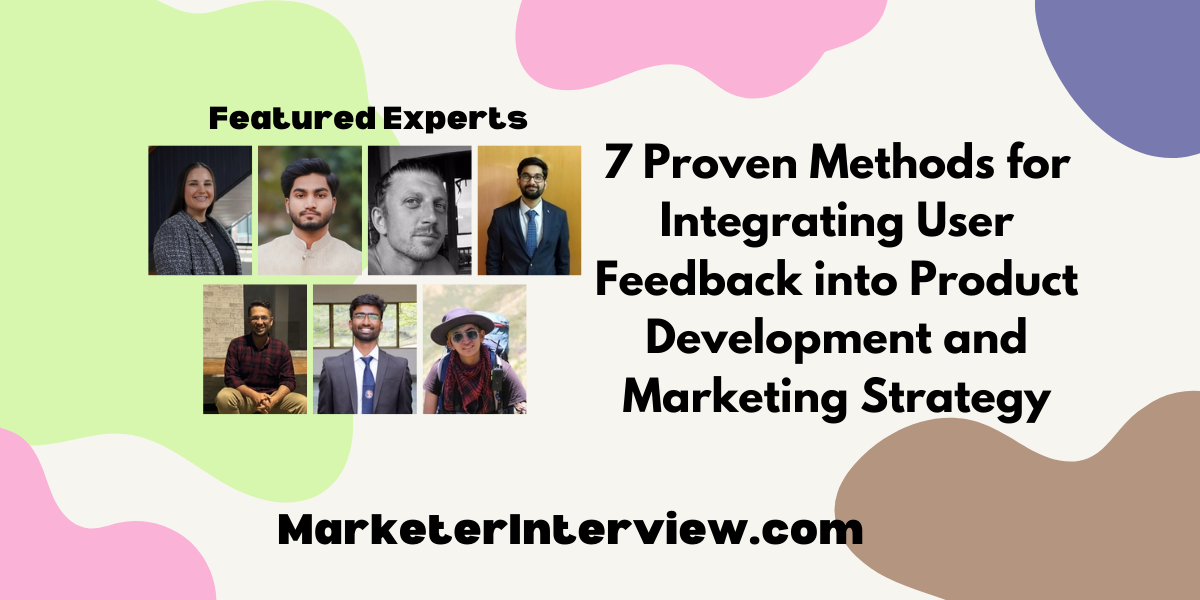7 Proven Methods for Integrating User Feedback into Product Development and Marketing Strategy
We’ve gathered seven innovative strategies from top professionals in marketing and product management on how to weave user feedback into the fabric of product development and marketing. From optimizing marketing with A/B testing to customizing flight experiences based on client suggestions, these insights from a Marketing Manager to a Director of Marketing & Technology reveal the power of listening to your users.
Want to get quoted in MarketerInterview.com content just like this? Apply to become a contributor today!
Contents
- 1 Optimize Marketing with A/B Testing
- 2 Revamp Features Using User Surveys
- 3 Discover Insights with End User Interviews
- 4 Enhance Products with Feedback Loops
- 5 Introduce AI-Driven Customer Service Solutions
- 6 Launch Beta-Tester Program for Product Feedback
- 7 Customize Flight Experiences from Client Suggestions
Optimize Marketing with A/B Testing
We’ve integrated user feedback into our digital marketing strategy by continuously implementing A/B testing methodologies. By testing different variations of our ads, landing pages, and email campaigns, we gather quantitative data on user preferences and behaviors. This iterative approach allows us to refine our marketing tactics based on real-time user feedback, ultimately optimizing conversion rates and driving higher engagement. This data-driven strategy ensures that our marketing efforts are aligned with the evolving needs and preferences of our target audience, leading to more impactful campaigns and improved overall performance.

Taylor Caplan, Marketing Manager, Duckpin
Revamp Features Using User Surveys
We added a new feature to our travel website that we thought was really cool. But soon, people told us it was too hard to understand. Instead of just sticking with it, we asked for their thoughts through surveys and social media to really understand what they didn’t like.
We used what everyone told us like a guiding star to make the feature better. We made it simpler and then shared the new version with our users. They liked it a lot more! More people started using it, and they said lots of good things about it.
Listening to what our users had to say turned a tricky situation into a win for us. It showed us how important it is to see our users as partners in making our product. Their ideas and opinions can really help make our stuff better.

Swena Kalra, Chief Marketing Officer, Scott & Yanling Media Inc.
Discover Insights with End User Interviews
A while back, I joined a project where we were tasked with updating one of our client’s timecard applications. The existing app was a decade old, but the client only wanted a fresh look for it and support to integrate it with the rest of the apps. However, when we spoke to the end users, we discovered something unexpected: hardly anyone was using the app actively. It turned out that data from the timecards was supposed to flow into the payroll system, but for some edge cases, users often had to manually enter the data into the payroll system themselves. Over time, these edge cases began to rise in numbers. As a result, each user devised their own offline methods for keeping records before inputting them into the payroll system. Additionally, we learned that there were talks with the payroll system vendor to possibly add timecard features directly into their system, of which the sponsors of this transformation were not aware. The knowledge, artifacts, and insights from the interviews then served as inputs for the customization of required features.

Ashish Khandalikar, UX Designer, IBM
Enhance Products with Feedback Loops
One specific approach that has been particularly successful is implementing a “feedback loop” system directly within our platform. This system allows users to easily submit their suggestions or concerns as they navigate our site. A memorable instance where this approach paid dividends was when several users suggested enhancements to our keyword tracking feature. By closely analyzing this feedback, we realized there was a demand for more granular, location-specific tracking capabilities.
Acting on this insight, we developed and introduced a new feature that allowed users to track keyword performance at a city level, not just nationally. The response was overwhelmingly positive, leading to a notable increase in user engagement and satisfaction. This direct integration of user feedback into our development process not only enhanced our product’s value but also reinforced our commitment to evolving in line with our users’ needs, demonstrating the profound impact of listening and responding to the voices of our community.

Sahil Kakkar, CEO & Founder, RankWatch
Introduce AI-Driven Customer Service Solutions
We provide a Customer Experience as a Service (CXaaS) platform tailored to elevate enterprise communication services and customer interactions. In response to customer feedback, we’ve introduced Docuwise, an innovative feature powered by artificial intelligence, enabling context-based answers to customer queries by comprehending documents and websites. By minimizing human intervention to essential tasks, we’ve achieved remarkable cost savings of up to 80% in contact center expenses for our clients.

Abhishek Achanta, Product Manager, Pinnacle Teleservices
Launch Beta-Tester Program for Product Feedback
We’ve successfully integrated user feedback into our product development by launching a beta-tester program for our new products, where selected customers provide detailed feedback on their experience. This direct input has allowed us to make targeted improvements before the official launch, leading to higher satisfaction and reduced post-launch modifications. It’s not only improved our products but also made our customers feel valued and part of the development process, strengthening brand loyalty.

John Frigo, eCommerce Manager, Best Price Nutrition
Customize Flight Experiences from Client Suggestions
One specific way we’ve integrated user feedback at JetLevel Aviation was by incorporating client suggestions into our bespoke flight-experience packages. After receiving feedback on the desire for more personalized in-flight services, we introduced customizable amenities such as gourmet catering options, specific entertainment preferences, and onboard productivity setups. This direct incorporation of client feedback into our service offering was highlighted in our marketing campaigns, showcasing our commitment to tailor-made luxury experiences. The result was a notable increase in customer satisfaction and loyalty, as clients saw their input directly influencing the service quality, thereby enhancing our market positioning as a customer-centric charter service.

Fahd Khan, Director of Marketing & Technology, JetLevel Aviation
Want to get quoted in MarketerInterview.com content just like this? Apply to become a contributor today!






